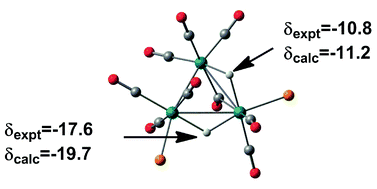Characterisation of tri-ruthenium dihydride complexes through the computation of NMR parameters†
Abstract
Density functional theory has been used to provide atomic-level detail on the structures of

* Corresponding authors
a
Department of Chemistry, Inorganic Chemistry Laboratory, University of Oxford, South Parks Road, Oxford, UK
E-mail:
john.mcgrady@chem.ox.ac.uk
b Department of Chemistry, University of Kufa, Iraq
c Department of Chemistry, University of York, Heslington, York, UK
Density functional theory has been used to provide atomic-level detail on the structures of

 Please wait while we load your content...
Something went wrong. Try again?
Please wait while we load your content...
Something went wrong. Try again?
M. A. M. Al-Ibadi, S. B. Duckett and J. E. McGrady, Dalton Trans., 2012, 41, 4618 DOI: 10.1039/C2DT12057G
To request permission to reproduce material from this article, please go to the Copyright Clearance Center request page.
If you are an author contributing to an RSC publication, you do not need to request permission provided correct acknowledgement is given.
If you are the author of this article, you do not need to request permission to reproduce figures and diagrams provided correct acknowledgement is given. If you want to reproduce the whole article in a third-party publication (excluding your thesis/dissertation for which permission is not required) please go to the Copyright Clearance Center request page.
Read more about how to correctly acknowledge RSC content.
 Fetching data from CrossRef.
Fetching data from CrossRef.
This may take some time to load.
Loading related content
